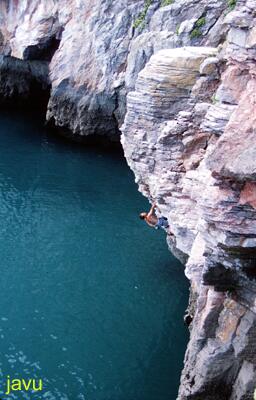Read on or go straight to the DWS contents Page
Introduction
In the past Deep Water Soloing has been marketed as a bit of a loony activity - this is probably pretty accurate when it comes to those lads from Dorset but down here in typical Devon style a day out Deep Water Soloing is a more relaxed affair involving much "dickin about" at the seaside. What normally happens is you arrive at the coast and fancy doing some climbing and end up accidentally committing yourself to a deep water solo. Then you're on it and getting pumped and think you're gonna fall off anyway so you try going a bit further and maybe even get up it but it doesn't matter if you don't coz falling off's a reet laff. Ace.
From the style point of view most of the routes were climbed very stylishly with cool egyptians and stuff. More interesting is the ethical style with many of the routes being climbed onsight. A mon avis one of the main reasons for Deep Water Soloing is that it's less effort than leading so you don't won't to be carrying ropes for inspection and stuff....or at least that was true until Mr. Unlazy himself, Martin Crocker came down late in 1998. As usual the words "ruthless efficiency" fit the Martin's developments and this was combined with some roped practice to tackle some of the lines that were a tad on the big side for onsight efforts.
The Grading System
Originating from Dorset, the "S grade" suggests the seriousness of a route. Several variable factors come into play here, sea-state and temperature being two obvious ones, which make it hard to pinpoint exactly how serious a route will be when you do it. The system breaks down into four categories, and these are not affected by how technically difficult a climb is. Thus a desperate sustained 9z/French 12y could get S0 (if it were a short distance above deep water), whereas an easy 1a could get S3 (if it was a long way above shallow water!).
S0 - Safe solo with
a good area of deep water.
S1 - not completely perfect water; with care injury is avoidable. Probably
highish and worth going around high tide.
S2 - Ah ha! Things start to get exciting now. A dangerous route, possibly
necessitating well aimed falling (consult Dorset geezers for advise on controlling
your fall whilst in the air). The water might not be that deep, or there
may be loose rock. High tide recommended.
S3 - Full on dangerous. You may as well be soloing above land - in fact
you'd probably be better off soloing above land as at least then if you
survive the fall you don't drown!
Tides
These are obviously a crucial factor in how deep the water is going to be! On many of the routes included you will need to be there within a few hours around high tide. The Climbers Club Website contains a tide time-table.
Gear
Take a load of chalk, chalk bags and boots as a dry set is desirable after each dunking.
Safety
With this sub-sport comes a whole new realm of risks. When you're on a normal roped crag you generally know where you stand - if you fall and hit the ground you assume that you are definately going to hurt yourself (most of the time!!). When Deep Water Soloing, things are not quite so clear cut as a whole range of factors will affect your chance of survival - sometimes the water will appear deep but turns out to be shallow over boulders; sometimes there is too much swell to be able to get back onto land; sometimes the temperature will seize your chest, stopping you from breathing; maybe you will knock yourself out when a hold breaks or as you fall...All of these need consideration to appreciate how dangerous what you are doing is.
- Be aware of the symptoms of Hypothermia as this is a very real risk, especially when committing to one of the longer sea-level traverses..


